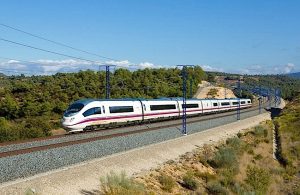
This has been another good year for Spanish tourism, which improves margins in the sector, and improves the quality of the destinations. The number of Irish tourists travelling to Spain has increased by 6% and is due to reach two million visitors for this year.
A prominent theme for Spain in general, and very much so for the tourism sector, is climate change and the actions and commitments to mitigate this. This month Spain hosted the UN Climate Summit (COP25) in Madrid. Our tourism sector has many companies actively committed to sustainable practices. While transport accounts for 27% of carbon emissions in Spain, our goal is to reduce this by 30% by the year 2030. Rail accounts for only 0.01% of these emissions and with 15.000 kilometres of rail network it is a major part of the Safe, Sustainable and Inter-Connected Mobility strategy of the government. Consider the high-speed train network when designing travel arrangements for yourselves and your clients.

One of our goals for tourism is to reduce seasonality and city breaks can be a main element of this. Consider our interesting and exciting cities such as Madrid, Malaga, Girona, Valencia, and Santiago – among others. New products (or lesser-known products) also contribute to removal of the seasonal effect (check the spain.info website for information on over 200 fairs and events of international interest). Food and wine itineraries provide enjoyable experiences – for example, we recently did a very pleasant fam-trip to the wineries of La Rioja region.
Rural tourism is another product that we are promoting to encourage visitors to inland regions such as Castile and León (the area of Burgos, Valladolid and Salamanca), inland Andalusia, and even inland on the Canary Islands with their year-round beautiful climate. For the increasingly popular walking product, some coastal destinations have developed boardwalks such as the Malaga coastal path, 160 kilometres of boardwalk from Manilva to Nerja due for completion next year. Salou has also built a spectacular boardwalk along its coastal cliffs, while Girona and Costa Brava have mapped out walks along their coast.
For the Camino de Santiago, 2021 is a Holy Year. The Camino de Santiago has left its mark on the millions of people who travel it each year, for different reasons – it could be religious devotion, personal growth, or to experience the historical culture and natural environment. The Jacobean Holy Years are when the pilgrims who visit the tomb of St James in Santiago receive full forgiveness for their sins from the church and these years see a large increase in the numbers of pilgrimages.
The Spanish tourism sector is very appreciative and fond of Irish tourists, as they are known to be friendly guests and high spenders. You can be sure of a warm welcome throughout Spain and a continued commitment to improving the quality of our accommodation and services.
We are honoured to have received the Best National Tourist Office Award at this year’s ITTN Awards, as voted by the Irish trade. Do not hesitate to contact us if we can help with contacts, information, images and marketing collateral ([email protected]).




